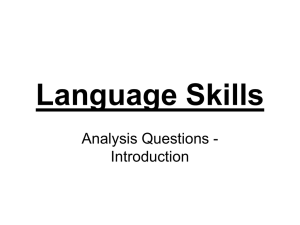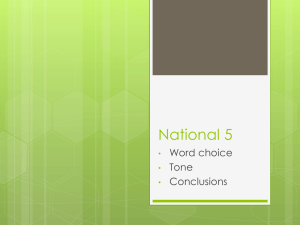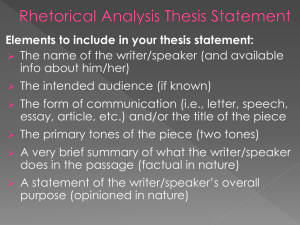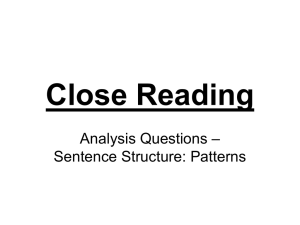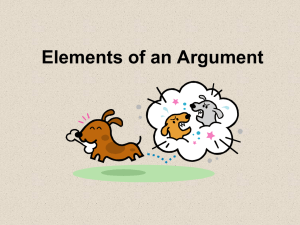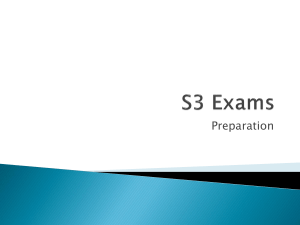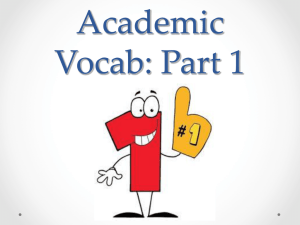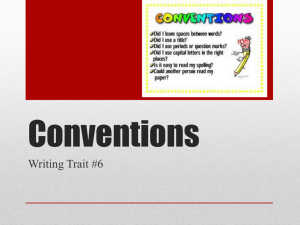National 5 Sentence Structure
advertisement
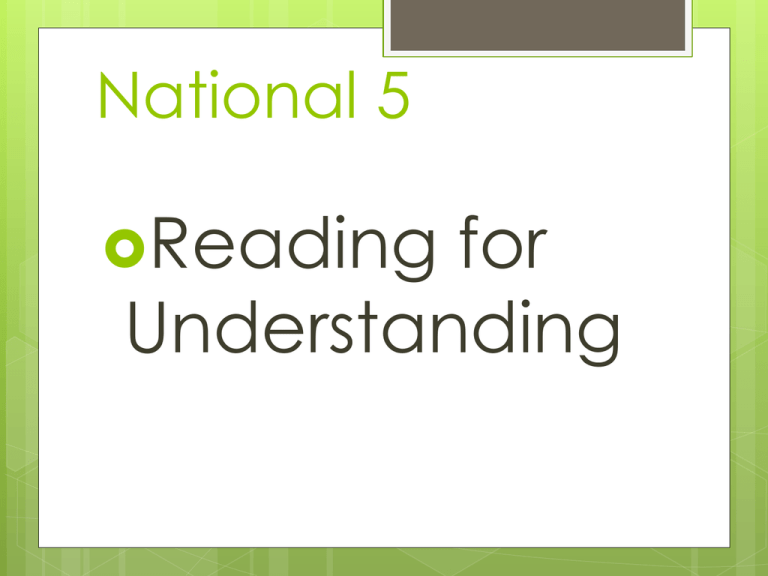
National 5 Reading for Understanding Sentence Structure Sentence Structure questions ask you to explain how a writer has put the sentence together. You can learn some of the possible techniques and what effect they would have on a sentence. When asked about sentence structure, work your way round the triangle, to see if there is anything interesting to comment on… When answering these questions always answer in two parts: • Name the techniques • Explain what effect it has in this situation exclamation repetition Start with… Types of sentence: • Statement – a simple statement of fact • Question – (rhetorical) to involve the reader or to show the confusion of the writer • Command - involves the reader in the passage • Minor sentence - to create a dramatic effect • Exclamation - To show strong emotions • Can you tell which of the following sentences is the statement, minor sentence, exclamation, command and rhetorical question? • Peacocks have bright blue plumage and a loud call. • Would you like to own a peacock? • Imagine having a peacock living in your back garden. • Great squawking things. • You must be joking! Once you have decided what type of sentence it is and whether it is worth commenting on, you move on to think about the pattern of the sentence. To answer the sentence structure question you must explain: • The technique being used • Why it is effective Climax and anti climax: When a sentence is built up and up towards the most important point, it has reached a climax. When it is built up and up and what follows is disappointing, that is an anti – climax. He had let himself down, he had let his family down, he had let his country down. • The writer has built the sentence up to a climax • in order to emphasise the fact that he has let so many people down, but most importantly, the whole of his country. He had let himself down, he had let his family down, he had let his arm-bands down. The writer has created an… Balance: Using a semi-colon, a writer will join two main clauses together to show that they are equally important. • I love you; you’re the best. • John was a gambler; John was a loser. • The dog was spotty; the cat was spotty. • The writer has used balance • to show that the dog was as important as the cat. Try this one. Comment on the sentence structure of the sentence below. • She worshiped ice-cream; she worshiped jelly. Juxtaposition: This is when a writer deliberately places two contrasting ideas next to each other to surprise the reader. Here is an example from ‘A Tale of Two Cities’ by Charles Dickens. • “It was the best of times, it was the worst of times, it was the age of wisdom, it was the age of foolishness…” • Dickens uses juxtaposition • to surprise us with the contrast in the way the world was at that time. Try this one. Comment on the sentence structure in the sentence below. He was the worst footballer I had ever seen. He scored more goals than anyone else in the team. Inversion: When Yoda speaks, he uses inversion! It changes the emphasis of the sentence, making different words seem important. • Silly that boy is, with a clothes peg on his nose. • The writer has used inversion. • It emphasises the word silly and so shows how foolish the boy was. • Screeching round the corner, the ambulance came. • The writer has used inversion. • Putting the verb first, emphasises the noise made by the ambulance Try this one. Comment on the sentence structure in the sentence below. • On the mat, sat the cat. Rule of 3: Writers use groups of three to emphasise their point. It might be 3 adjectives or verbs/ or adverbs/ 3 phrases/ 3 examples. • She is kind, thoughtful and considerate. • The writer uses the rule of 3, with three adjectives • to emphasise what a nice person this is. Try this one. Comment on the sentence structure in the sentence below. • If you stay up until 2.00 a.m. you will be tired, you will be grumpy and you will be unbearable. Listing: By using a list in a sentence, the writer emphasises the quantity of something or how busy someone is. • Since getting on the train twenty minutes ago, she had managed to bang her head; stub her toe; knock over a cup of coffee; insult the ticket collector and drop her handbag on an old lady’s lap. • The writer uses a list • to show what a series of disasters had happened to the woman on the train. Try this one. Comment on the sentence structure in the sentence below. • The circus had come to town: acrobats, clowns, trapeze artists, lion tamers, fire-eaters, bare-back horse riders thronged the platform. • Parenthesis: • A word or phrase which adds extra information to a sentence and is marked off by brackets or dashes or commas. • You must say what the extra information is about… • The zebra (with loud black and white stripes) was not unnoticeable in the field of horses. • The writer uses parenthesis • to add the information about why the zebra would stand out – because of his stripes. Try this one. Comment on the sentence structure in the sentence below. • Three toddlers ( with sticky, jam-covered fingers) descended on my new sofa. Repetition: Writers repeat words, phrases or ideas to emphasis their point. • Churchill: “…we shall fight on the beaches, we shall fight on the landing grounds, we shall fight in the fields and in the streets, we shall fight in the hills; we shall never surrender.” • Churchill uses repetition of the phrase ‘we shall fight’ • in order to drive home his point that the fight shall go on everywhere it is required. Try this one. Comment on the sentence structure in the sentence below. • “He's passed on! This parrot is no more! He has ceased to be! He's expired and gone to meet his maker! He's a stiff! Bereft of life, he rests in peace! If you hadn't nailed him to the perch he'd be pushing up the daisies! His metabolic processes are now history! He's off the twig! He's kicked the bucket, he's shuffled off his mortal coil, run down the curtain and joined the bleedin' choir invisible! THIS IS AN EX-PARROT!”

